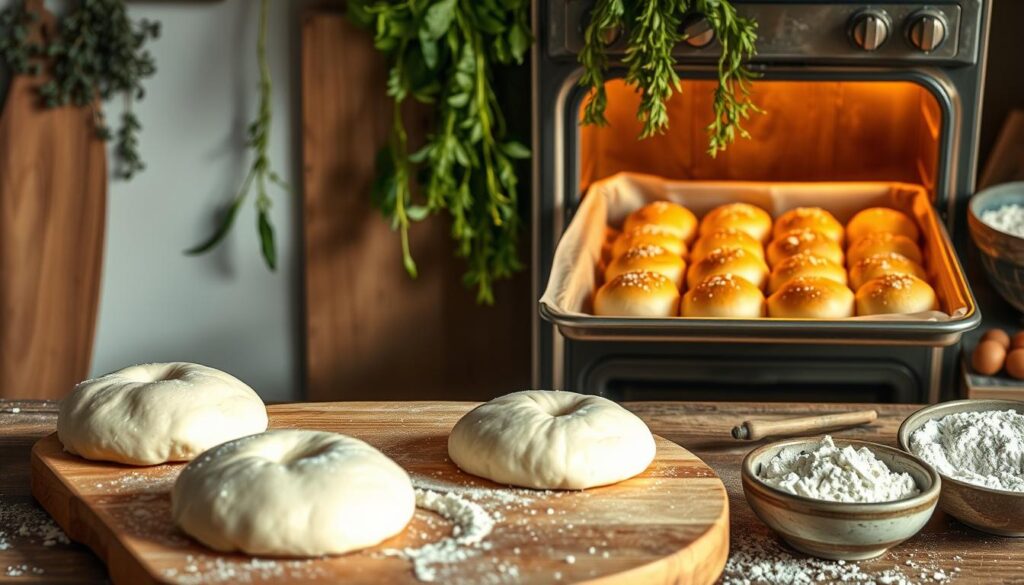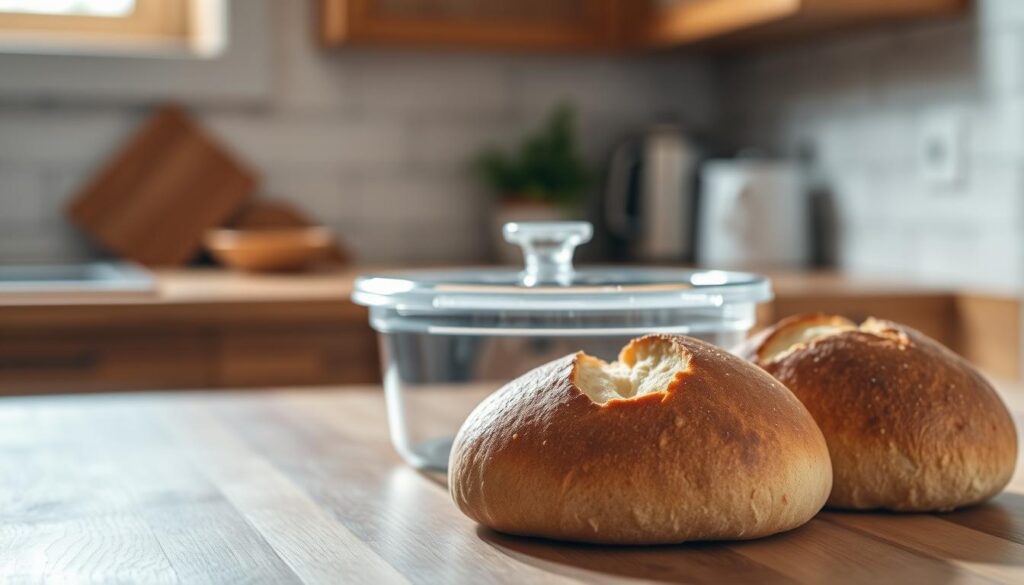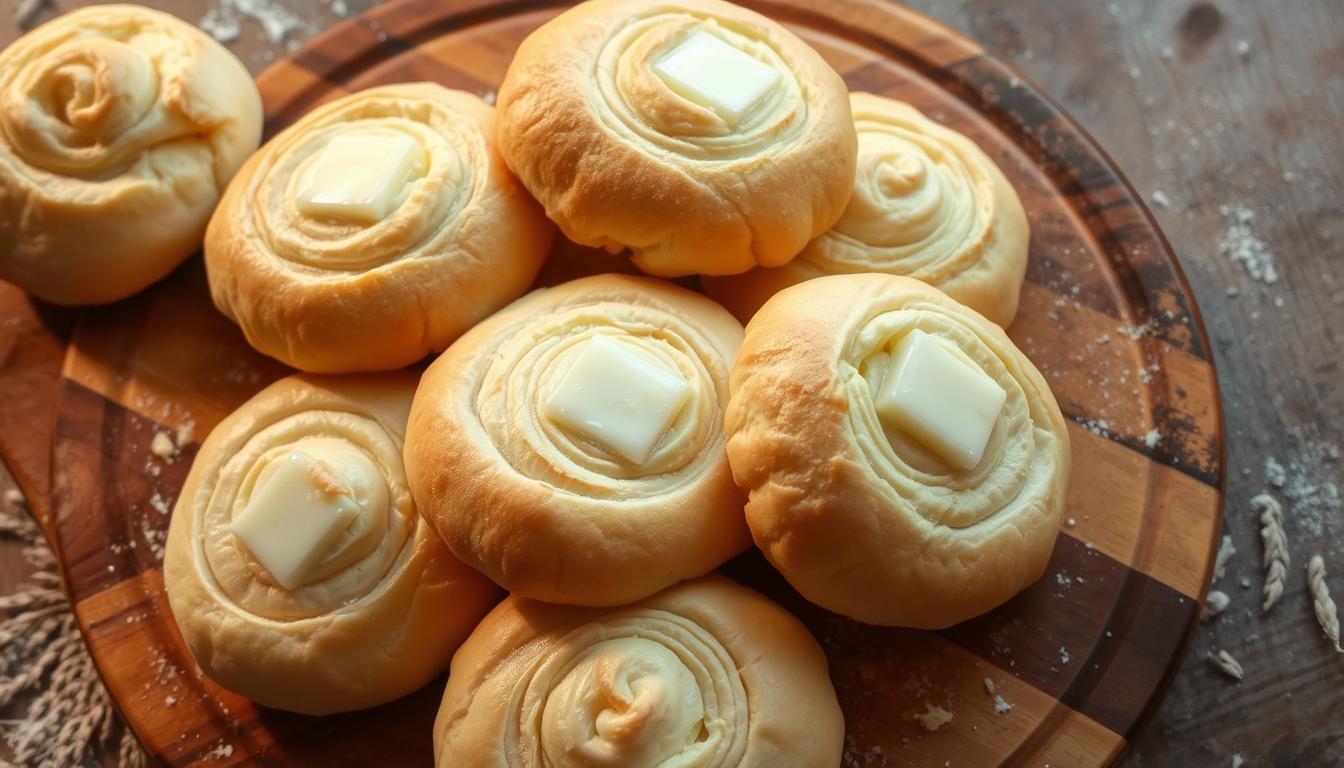Table of Contents
“Waste not, want not.” Benjamin Franklin’s words are very true in the kitchen. If you bake with sourdough, you face the challenge of excess starter. But what if you could make something amazing from it?
Sourdough discard rolls turn leftovers into something special. They’re not just a recipe; they’re a solution. Instead of throwing away unused starter, you make soft, tangy rolls full of flavor. The recipe sourdough rolls method makes baking a zero-waste success.
Every spoonful of sourdough discard is full of potential. These sourdough rolls recipe creations are a celebration of creativity. Imagine having warm, airy rolls on your table, made from what others might ignore. It’s not just baking; it’s reinventing.
Key Takeaways
- Repurpose sourdough discard to cut waste and boost flavor.
- These rolls require minimal effort but deliver maximum taste.
- Perfect for beginners and experienced bakers alike.
- Learn a technique that aligns with sustainable cooking trends.
- Discover how tangy, homemade sourdough rolls recipe elevate everyday meals.
Understanding Sourdough Discard and Its Benefits
Keeping a sourdough starter alive means feeding it flour and water regularly. The leftover is called sourdough discard. This tangy mix is a key ingredient in sourdough dinner rolls. It’s worth knowing why.
What is Sourdough Discard?
When you feed your starter, you take out some to keep it healthy. This leftover is full of wild yeast and lactobacilli. Instead of throwing it away, use it to make rolls. It adds natural acids and enzymes that boost taste and texture.
Why You Shouldn’t Throw Away Your Discard
- Reduces food waste by repurposing 100% of your starter.
- Saves money by eliminating need for commercial yeast.
- Maximizes ingredient efficiency for homemade baking.
Flavor Benefits of Using Discard in Rolls
Discard’s fermentation process adds depth, like long-fermented breads. Here’s how it improves rolls:
| Aspect | Benefit to Sourdough Dinner Rolls |
|---|---|
| Flavor Complexity | Develops subtle tang and nutty notes |
| Texture | Creates airy interiors with chewy crust layers |
| Digestibility | Acids break down gluten for easier digestion |
These traits make sourdough dinner rolls taste richer than store-bought bread. Plus, they’re easier on your stomach.
Essential Ingredients for Perfect Sourdough Discard Rolls
Making homemade sourdough rolls begins with the right ingredients. Your sourdough discard is the base. But other ingredients shape the taste and texture. Here’s what you need:
- Flour: Pick bread flour for chewy crusts, all-purpose for balance, or whole wheat for a nutty taste.
- Salt: Use kosher or sea salt to boost fermentation and flavor without being too strong.
- Fat: Butter adds richness, while olive oil keeps the rolls moist.
- Sweetener (optional): A teaspoon of honey or sugar can help start fermentation if needed.

| Ingredient | Purpose | Tip |
|---|---|---|
| Bread flour | Strengthens gluten structure | Use 70-80% hydration for rolls |
| Discard | Natural leavening agent | Use 24-hour-old discard for best flavor |
| Salt | Controls yeast activity | Never skip—critical for flavor balance |
Try substituting up to 30% of flour with rye or spelt for different textures. Always use fresh ingredients—stale flour can weaken the rise. These basics turn discard into golden, airy homemade sourdough rolls full of tangy flavor.
Equipment You’ll Need for Baking Success
Mastering the best sourdough rolls recipe starts with the right tools. Every baker’s kitchen needs a few essentials for consistent results. This guide helps you know what’s crucial and what’s optional.
Basic Baking Tools
Start with these must-haves:
- Mixing bowls (stainless steel or glass)
- Measuring cups and spoons
- Baking sheet or stone
- Plastic wrap or a clean kitchen towel
Optional Specialty Equipment
Upgrade your process with these items:
- Digital kitchen scale for precise measurements
- Bench scraper for handling dough
- Proofing baskets for shaped rolls
- Dutch oven for steam retention
Alternatives for Common Tools
Stretch your resources with smart swaps:
Use a colander or clean dishtowel as a proofing surface. A standard oven tray works if you lack a baking stone. Even a microwave-safe bowl inverted over dough can create steam—no Dutch oven needed. Choose tools that fit your baking frequency to avoid clutter.
Step-by-Step Recipe Sourdough Rolls Instructions
This sourdough roll baking guide makes it easy, even for beginners. Follow these steps for great results.

Preparing Your Discard
Begin with ripe discard, fed 4–6 hours before baking. Let it warm up. Then, mix it with warm water to wake up the yeast.
Mixing the Dough
- In a bowl, mix discard, flour, and water until it’s shaggy.
- Knead for 10 minutes until it’s smooth. Add salt halfway.
Fermentation and Folding Techniques
Let the dough rest for 4–6 hours at 70–75°F. Fold it gently three times: after 1st, 2nd, and 3rd hours. This makes the dough strong without overworking it.
Shaping Your Rolls
- Divide the dough into equal parts.
- Make rounds by tucking edges under with floured palms.
- Place on a greased baking sheet, cover, and proof for 30 minutes.
Baking to Perfection
Preheat the oven to 450°F with a pan on the bottom. Score the tops lightly, then bake for 15–20 minutes. Check if it’s done by tapping; the base should sound hollow.
The Science Behind Fluffy Sourdough Rolls
Ever wonder why sourdough discard turns into airy, tender rolls? The science starts with fluffy sourdough rolls relying on two key players: wild yeast and lactic acid bacteria. These microbes work together to create the perfect balance of rise and flavor.
Wild yeast eats sugars in your dough, releasing carbon dioxide gas. This gas gets trapped by gluten strands, puffing the dough. At the same time, bacteria produce lactic acid, which gives sourdough its tangy taste and helps tenderize the crumb structure. Fluffy sourdough rolls depend on this microbial teamwork.
Hydration levels matter too. Water content determines dough consistency: 65-75% hydration creates the ideal stretchy texture for light rolls. Gluten networks form when dough is gently folded during rest periods, creating pockets that expand during baking.
| Factor | Impact | Optimal Range |
|---|---|---|
| Yeast activity | Gas production for rise | 70-80°F (21-27°C) |
| Gluten development | Structural support | 2-4 folding sessions |
| Acid production | Flavor development/enzyme activation | 4-8 hour fermentation |
Enzymes in sourdough discard break starches into sugars, fueling fermentation and creating golden crusts through the Maillard reaction. Balancing these factors ensures fluffy sourdough rolls with open crumb and complex flavor. Adjust hydration or fermentation time to tweak your results—now you know why science matters in every bite.
Creative Variations to Try with Your Basic Recipe
Turn your sourdough discard into artisan sourdough rolls with these fun twists. Try new flavors and textures to make your baking stand out. These ideas will make your kitchen a place of creativity for homemade bread.
Sweet Sourdough Roll Options
- Cinnamon-Sugar Swirl: Mix 1 tsp cinnamon and 1 tbsp sugar into the dough before shaping. Roll into logs and slice into buns.
- Orange Cardamom Knots: Add zest of 1 orange and ½ tsp ground cardamom. Shape into pretzel-like knots for a breakfast treat.
- Vanilla Bean Buns: Split a vanilla bean, scrape seeds into the dough, and bake as rolls. Perfect for ice cream or coffee cakes.
Savory Flavor Additions
For savory artisan sourdough rolls, try these additions:
- Roasted Garlic & Herb: Blend 2 roasted garlic cloves with 1 tbsp chopped rosemary. Fold into dough before shaping.
- Cheese-Stuffed Rolls: Mix shredded cheddar or feta into dough. Let it rise, then bake for gooey centers.
- Sun-Dried Tomato & Olive: Stir in ¼ cup each of finely chopped sun-dried tomatoes and kalamata olives. Serve with dips.
Whole Grain Alternatives
| Flour Type | Hydration Adjustment | Example Use |
|---|---|---|
| Spelt Flour | Reduce water by 10% | Blend 50/50 with all-purpose flour for tender texture |
| Rye Flour | Add 2-3 tbsp extra water | Use 20% rye for earthy depth |
| Emmer Flour | No change | Replace 30% of flour with emmer for nutty flavor |
When using whole grains, fermentation time may be 30 minutes longer. Their enzymes can slow down the rise.
Troubleshooting Common Sourdough Roll Problems
Mastering sourdough bread rolls takes patience. But, you can fix common issues with a few tweaks. If your dough isn’t rising or your rolls taste wrong, these tips will help.
Dough Not Rising Properly
- Test starter activity: Mix discard with flour and water; active bubbles mean it’s ready.
- Check proofing temperature: Keep dough in a 75–80°F environment to activate yeast.
- Extend fermentation time: Let dough rest longer if it hasn’t doubled in size.
Fixing Overly Dense Rolls
- Adjust hydration: Add 1–2 tablespoons water if dough is too stiff.
- Optimize kneading: Ensure gluten development through stretch-and-fold techniques.
- Preheat pans: Use a preheated Dutch oven to create steam and lift volume.
Addressing Flavor Issues
- Balance sourness: Reduce fermentation time for milder taste or age starter longer for complexity.
- Refresh ingredients: Use filtered water and high-quality flour for better flavor.
- Experiment with salt: Adjust by ¼ teaspoon increments to enhance taste balance.
Every tweak improves your baking. Keep a baking journal to track what works in your kitchen.
Storage and Freezing Guidelines
Keeping your sourdough bread rolls fresh is key. Cool them down completely on a wire rack after baking. This helps keep their texture and taste just right.

- Wrap loosely in a clean kitchen towel or parchment paper
- Store in a paper bag at room temperature
- Avoid plastic wrap to prevent sogginess
Freezing is a great way to keep rolls fresh for up to 3 months. Here’s how to do it:
- Cool rolls completely to room temperature
- Wrap individually in parchment paper
- Place wrapped rolls in a freezer-safe bag or container
- Label with the date before freezing
To refresh frozen rolls, bake at 300°F (150°C) for 10-15 minutes. For a quick fix, microwave defrosted rolls on high for 10-15 seconds. If rolls smell bad or look off, toss them after 3 months.
Choosing the right storage keeps your rolls light and crispy. Adjust your method based on your climate and how often you eat them.
Serving Suggestions for Your Homemade Sourdough Rolls
Make your homemade sourdough rolls even better with these creative ideas. They’re great as a base for spreads or as the main attraction in a sandwich. These rolls pair well with many things.
Complementary Spreads and Butters
Top homemade sourdough rolls with compound butters for a burst of flavor. Try these:
- Herb butter: Mix parsley, chives, or rosemary into softened butter.
- Honey-infused butter: Stir in local honey for a sweet-tangy contrast.
- Roasted garlic spread: Mash roasted garlic cloves into softened cream cheese.
- Sun-dried tomato butter: Blend sun-dried tomatoes with olive oil and salt.
Making Sandwiches with Your Rolls
Split rolls in half for sturdy sandwiches. Here are some great fillings:
- Smoked turkey with avocado and Dijon mustard
- Grilled chicken salad with bacon and blue cheese dressing
- Crispy tofu or chickpea salad for vegetarian options
Pairing with Soups and Meals
| Soup Type | Roll Pairing |
|---|---|
| Tomato soup | Garlic-infused rolls |
| Beef chili | Herb rolls with melted cheese |
| Minestrone | Whole wheat rolls with pesto |
Serve homemade sourdough rolls warm at dinner parties or with hearty meals. For holidays, drizzle with honey and cinnamon for a sweet treat.
Time-Saving Tips for Busy Bakers
Even with a busy schedule, making easy sourdough rolls can fit into your routine. These tricks streamline prep without sacrificing taste or texture.
- Batch Baking: Double your recipe and freeze half. Store dough in airtight containers for up to 3 months. Thaw only what you need.
- Cold Fermentation: Refrigerate dough after mixing. A 12-hour fridge rest reduces active work while developing flavor.
- Prep Stages: Divide steps into 15-minute chunks. Mix dough in the morning, refrigerate, then shape rolls in the evening before baking.
- Tool Efficiency: Use a dough whisk or stand mixer to cut mixing time. A proofing basket speeds shaping.
- Freeze Portioned Dough: Shape rolls first, freeze on parchment, then store in bags. Bake directly from frozen—add 2-3 minutes to baking time.
Adjust the process to match your availability. By leveraging cold fermentation and strategic pauses, easy sourdough rolls become a quick option for meals or snacks. Prioritize steps that save time without compromising results.
The Health Benefits of Sourdough Compared to Commercial Bread
Choosing the best sourdough rolls recipe is more than just about taste. It’s a step towards better health. Sourdough’s long fermentation process changes bread in ways that can benefit your body. Let’s explore why this traditional method might work better for you than store-bought options.
Digestibility Advantages
Long fermentation breaks down gluten and starches into simpler forms. This makes sourdough rolls easier to digest than commercial bread:
- Lactic acid bacteria reduce phytic acid, which blocks mineral absorption
- Enzymes in starter pre-digest proteins, easing digestion for some
- Lower gluten content compared to rapid-rise loaves
Nutritional Profile of Sourdough Discard
Using discard in your rolls adds unique nutrients. Fermentation:
- Increases B vitamins and trace minerals like magnesium
- Preserves nutrients by reducing anti-nutrient compounds
- Creates a slower carbohydrate release for steady energy
Lower Glycemic Impact
Compared to white bread, sourdough’s acidity slows sugar absorption. Research shows:
- Glucose spikes reduced by up to 30% in sourdough vs. commercial bread
- Organic acids delay carbohydrate digestion
- Higher fiber retention from whole grain recipes
When you bake the best sourdough rolls recipe, you’re not just avoiding waste. You’re choosing a bread that supports your body’s natural rhythms. Let science guide your next kitchen experiment!
Conclusion: Turning Waste Into Wonderful Bread
Turning sourdough discard into artisan sourdough rolls is more than practical. It’s a celebration of creativity and resourcefulness. Each batch you bake not only reduces food waste but also creates bread with deeper flavor and better digestibility than store-bought options.
The techniques we’ve covered, from mixing dough to mastering fermentation, empower you. They help you turn what’s often discarded into something exceptional. This process is a step toward mindful eating and a connection to the craft of baking.
Remember, even small adjustments like adding herbs or seeds can make these rolls unique. Troubleshooting tips ensure consistency, while freezing and storage methods keep your efforts efficient. By embracing this process, you join a community of bakers committed to sustainable practices and traditional methods that prioritize quality over convenience.
Explore new flavor combinations, share your creations with friends, or experiment with other discard recipes. Each loaf you make reinforces the joy of hands-on cooking and the pride of minimizing waste. Whether enjoyed with butter, turned into sandwiches, or shared at gatherings, these rolls symbolize both skill and mindfulness in the kitchen.
FAQ
What is a sourdough roll?
A sourdough roll is a bread roll made with sourdough starter. This starter is a mix of flour and water with wild yeast and bacteria. It gives the roll a unique flavor, a chewy texture, and a crusty outside.
How do I make homemade sourdough rolls?
To make sourdough rolls at home, mix sourdough discard, flour, water, and salt. Follow a recipe that guides you through mixing, fermentation, shaping, and baking.
Can I use all-purpose flour for sourdough rolls?
Yes, you can use all-purpose flour for sourdough rolls. But, bread flour makes them chewier because it has more protein. Try different flours to find your favorite.
What makes these the best sourdough rolls recipe?
This recipe is top-notch because it uses sourdough discard for better flavor and texture. The fermentation makes the rolls more digestible and tastier than those made with commercial yeast.
How do I store sourdough dinner rolls to keep them fresh?
Let sourdough dinner rolls cool completely before storing. Use a paper bag, cloth wrap, or airtight container. For longer storage, freeze them and reheat in the oven.
What are some easy variations for my sourdough dinner rolls?
Try adding herbs, cheese, garlic, or cinnamon to your sourdough dinner rolls. This way, you can make them taste like your favorite flavors.
How do I troubleshoot common problems with my sourdough rolls?
Issues like not rising or lacking flavor can be fixed. Make sure your sourdough starter is active, adjust the dough’s moisture, and watch the fermentation time. Check your environment and baking techniques.
Can I use dried yeast in addition to my sourdough starter?
Yes, you can add dried yeast to your sourdough starter. It helps with rising and speeds up fermentation. This is great for beginners.
What are the health benefits of sourdough compared to regular bread?
Sourdough bread is easier to digest because of fermentation. It breaks down gluten and phytic acid, making nutrients more available. It also has a lower glycemic impact than regular bread.
What equipment do I need to make sourdough rolls?
You’ll need mixing bowls, measuring cups, a bench scraper, baking sheets, and an oven. Optional tools like a kitchen scale or proofing basket can improve your baking.

